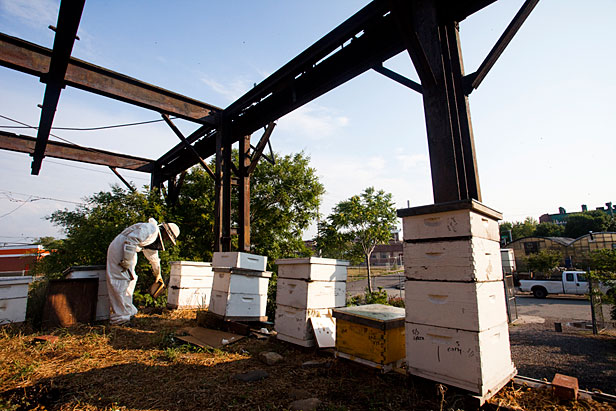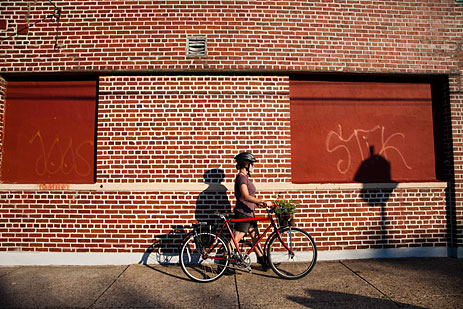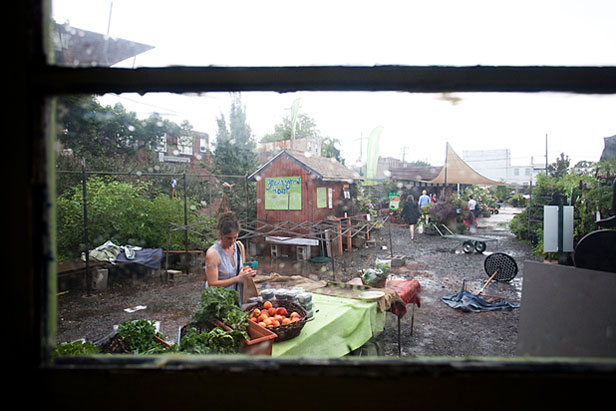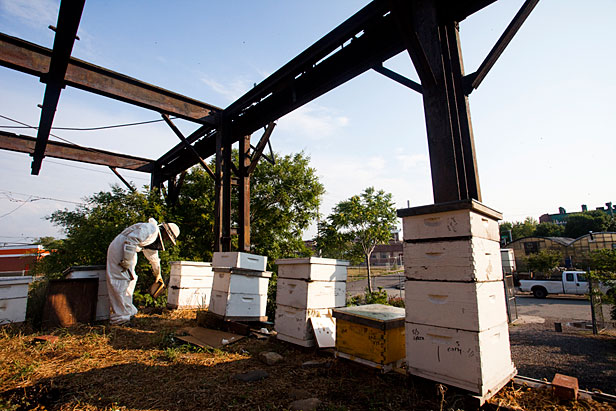 Mary Seton Corboy sweating in her bee suit on the living roof of the Greensgrow farm’s storage trailer.(Photos ©Michael Hanson)
Mary Seton Corboy sweating in her bee suit on the living roof of the Greensgrow farm’s storage trailer.(Photos ©Michael Hanson)
It’s sunny and 94 degrees, and the pavement’s steaming after a thunderstorm rolled sideways through north Philly. Mary Seton Corboy wears a full-body, white bee suit. She stands atop a small trailer’s grassy roof on a vacant city lot. Smoke puffs from the antique-looking box in her hand, and the bees calm down.
“We put these up here originally just for security,” she says. “Figured no one would bother the equipment with a bunch of bees around.”
Mary has created a small world, called Greensgrow, here on one block. The trailer under the beehives holds farm tools. Beside the trailer, tanks for the biodiesel conversion operation transform used cooking oil into fuel for Big Yellow, the delivery truck that collects fresh produce and meat and dairy products from farms within 75 miles of this square of green in Philadelphia’s Kensington neighborhood. That food goes into the homes of 400 CSA members, some of them low-income, and for sale at the farm’s market. That is to say, the Greensgrow farm and nursery is a little bit of everything, and all of it connected, somehow, like any good old city.
Farming in Kensington, now a low-income neighborhood largely populated by Russian and Polish immigrants, is no more new than it is throughout Philadelphia. Community gardens, backyard gardens, and “guerrilla” gardens on vacant lots have been producing thousands of pounds of fresh food annually for over a century. The Vacant Lot Cultivation Association, begun in 1897, helps people access land and start market gardens. War rationing during WWI and II spurred Victory Gardens, as they did in many cities. And the early-to-mid-century exodus of African-American farmers from the sharecropper South brought a new agrarian population to the city.
There weren’t meetings or board members or conference calls. Just a need for food, empty land, and people who knew how to dig in with a shovel and hoe.
Then the community vacant-lot gardens took off in the ’70s, just as the industrial boom imploded. More than 100,000 people lost their jobs, industries ran screaming, and many people bolted for the hills, or somewhere not-Philly.
At the same time, another wave of southern African-Americans moved north, this time in conjunction with a Puerto Rican migration and Southeast Asians escaping the poisonous aftermath of the Vietnam War. Having grown their own food in their homelands, the newcomers brought that knowledge and ethic with them.[1]
The city, meanwhile, took little interest in its agencies’ land holdings, so they barely blinked at signing multi-year leases to neighborhood farmers on empty city lots. The 1970s made inner-city blightification as American as apple pie. In Philly, pirate farmers built soils, and fed families and communities. The common-sense food production continued into the ’90s. There weren’t meetings or board members or conference calls. Just a need for food, empty land, and people who knew how to dig in with a shovel and hoe.
Mary calls a shovel “the idiot stick,” and she holds it in high regard. She came onto the scene at the tail end of that mini-urban-ag revolution. Plenty of vacant-lot and community farms still exist in Philly, but not on the scale they did 30 years ago. The decline is partly due to older farmers passing away, and partly due to increased real-estate values, the subsequent interest of developers, and city agencies’ reluctance to continue signing those multi-year leases on the empty lots. The rogue farmers have had to abandon soils they’d developed over a decade or more.

Many of Greenpoint’s market customers come on bike.
Mary doesn’t like meetings, and she looks far more comfortable in the bee suit and mask than I imagine she would in a pantsuit or dress. She’s a gritty farmer with a helluva business sense. When she takes off the bee suit, she reveals a dusty, wrinkled Subaru farm shirt. Two Subaru wagons sit along the curb between the bee and tool lot, and the larger farm and nursery — the socially progressive Subaru company financially sponsors Greensgrow.
Tom Sereduk, cofounder of Greensgrow, and Mary starting digging into Kensington in 1998. The two had restaurant experience and they saw a market for salad greens. Since they knew hydroponic growing methods (growing in water, rather than soil, with mineral supplements), they could bypass the immediate concerns over the lot’s EPA brownfield status. They opened during the growing season and sold to white-table cloth restaurants for a profit.
But Mary and Tom were like energetic hippies rolling in for half the year to grow fancy lettuce for fancy restaurants, and kids threw rocks at them over the fence. Though Tom opted out of the depressing situation, Mary stuck with it and she kept her vision open.
“Over time, we never really invested in any one thing, so when the winds of change moved in — more and more interest in local foods — we shifted. We started growing more heirloom tomatoes and micro-greens. Then we built the greenhouse, grew flowers, stayed year-round, and the neighbors got interested,” she says. “We saw what people grew in their pots here in the neighborhood and we offered them in the nursery. As we’ve grown, we’ve tried to keep one foot in this community and one in the greater city.”
At the corner of the farm, the chickens peck at the soil on one side of the chain-link fence, while neighbors cruise on bikes or stroll the sidewalk a foot away. It’s an easy symbol of the urban farm, but it actually does what you’d think it would. A few women sit on the steps of their row-houses a block away; their young kids bump Razor scooters over the sidewalk cracks, and they love the chickens.
 An afternoon thunderstorm ripped through Kensington neighborhood but only partially slowed down Greenpoint’s Thursday market.
An afternoon thunderstorm ripped through Kensington neighborhood but only partially slowed down Greenpoint’s Thursday market.
Janice Teague has lived here for 25 years. She likes the farm. She goes every week to the Thursday market for fruit and vegetables, and she buys tomato plants to grow in her backyard garden, a 6-foot-by-2-foot sliver of soil in the tiny concrete-floor-and-cinder-block-walled back patio. She doesn’t have a car, so she can’t get to Home Depot to buy potted plants. Greensgrow lets her use the wagon to roll her purchases home, and the nursery prices are no more than Home Depot’s or Lowe’s.
“I’m not into the butter and milk and cheese stuff,” Janice says. “I get that from the regular grocery store. My daughter gets her soap from the farm. I get fruit and bread, and I get flowers that I plant in my backyard. I get peppers, cucumbers, tomatoes. They’re fresher and they’re a little more money, but I like Jersey tomatoes from the farm market better than the supermarket ones.”
Janice doesn’t see many neighbors at the Greensgrow market. The people she sees there are from elsewhere. They’re nice, but she can tell that they’re “uppy.”
I see that, I guess, as I look at the Thursday market shoppers: young folks with mustaches on their faces and baskets on their bikes, a double date popping out of a Prius, a mom with a stroller the size of a Peugeot. But there’s also a policeman and the owner of the auto-detail shop across the street.
“When you become an asset to your community or neighborhood then you’ve done something. I don’t do this just to be tan.”
Mary has always intended for Greensgrow to be profitable. She wants it to be a model for sustainable profitability, in fact. All 19 staff members are paid by the for-profit side of the business, from nursery and farm sales, which grossed $1 million last year. The Community Supported Agriculture program has 400 members. That’s enormous for a city-block-size farm, but Greensgrow has created a 75-mile web of farms and producers with the Greensgrow CSA as the mothership distribution point. It’s so big that they’ve achieved the holy grail of the CSA model — a low-income option.
It’s been a dozen years since Mary ducked rocks while hanging plastic over the greenhouse. The bees help, but mainly she and her staff and her chickens and the nursery’s petunias have put a face on the farm and the neighborhood.
“In the short term I see a positive change. I got a Google alert last night. I don’t usually check those, but I did this time. It was from a real estate listing. It said, ‘Great house, great location right next to Greensgrow Farm!!!’ When you become an asset to your community or neighborhood then you’ve done something. I don’t do this just to be tan.”
[1] Source: the Community Gardening in Philadelphia, 2008 Harvest Report compiled by Domenic Vitiello and Michael Nairn of the Penn Planning and Urban Studies, University of Pennsylvania. October 2009
All content ©Breaking Through Concrete, adapted with permission. For information regarding use of images, video, or text, please contact btctour@mail.com.




